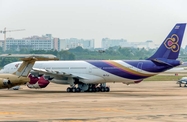With the Asia-Pacific region set to be the fastest-growing market for commercial aviation over the next 20 years, Thailand is seeking to strengthen its aviation infrastructure, and particularly its maintenance, repair and overhaul (MRO) segment.

A major step towards this took place in late June, when Thai Airways International (THAI) and European aerospace giant Airbus signed an agreement to proceed with a joint venture MRO facility at U-Tapao International Airport (UTIA).
According to the press release accompanying the deal’s announcement, the complex will allow for the analysis of aircraft maintenance data using the latest digital technologies, and will feature specialised repair shops and a maintenance-training centre.
The MRO centre will be one of a number of projects undertaken at UTIA in the coming years, with Uttama Savanayana, the minister of industry, revealing in late May that terms of reference for UTIA’s redevelopment as part of a regional aerospace centre called Eastern Airport City (EAC) were being drafted and would be released in July.
“The development of the airport should enable Thailand to create a vibrant and innovative MRO industry,” Pierre Jaffre, president of Asia-Pacific for Airbus Group, told OBG. “Furthermore, our joint venture MRO with THAI will allow us to create advanced maintenance facilities capable of handling all wide-body aircraft types.”
THAI and Airbus have been allocated a 32-ha plot within an 80-ha MRO centre, with initial operations to begin in 2022.
Citing rising demand for MRO services, THAI has projected annual revenue from the facility to average BT3bn ($90.5m) in the first 10 years of operation, rising to BT50bn ($1.5bn) in 50 years.
THAI to provide MRO at Don Mueang International Airport
Thailand continues to make progress towards developing its Eastern Economic Corridor (EEC), having published the 2018 EEC Act in the Royal Gazette in May, and work at UTIA in Rayong Province will play a key role in fulfilling the state’s ambitions for the area. These include the development of 11 targeted industries – of which logistics and aviation is one – in the eastern provinces of Chachoengsao, Chonburi and Rayong.
Another facility that is important in this sense due to its proximity to the EEC is Bangkok’s Don Mueang International Airport (DMIA). MRO prospects at DMIA also received a boost in June, when THAI and aircraft engine manufacturer Rolls Royce announced a commercial tie-up that will see the local company undertake repair and maintenance services for the UK firm’s Trent engines at the airport.
While THAI uses the Trent engines in its own aircraft fleet, the authorised maintenance centre – to be opened next year – will also be able to serve other carriers in the region.
Regional uptick in air travel bodes well for MRO
The demand for MRO services in the Asia-Pacific region will be driven by a sharp increase in passenger numbers, according to the International Air Transport Association (IATA), which projects average annual growth of 4.7% through to 2035. This would take passenger numbers to 3.1bn – up from the 1.3bn in 2016 – and make the region the largest single market globally.
However, even this figure could be on the low side, as Asia-Pacific carriers saw demand rise by 9.4% in 2017, which was above the global average of 7.6% for the year, the IATA reported in February.
To meet the demand for seats, aircraft numbers operating on Asia-Pacific routes are forecast to almost triple over the coming 20 years, rising from some 6000 to 17,000 – a strong indicator of the potential for regional MRO services.
Indeed, estimates value the global commercial aviation engine aftermarket at around $25.9bn for this year, up by 10% on the 2017 figure of $23.4bn.
Fulfilling the goals of Thailand 4.0
The push to raise country’s profile in the MRO market is in line with the government’s Thailand 4.0 industrialisation policy, which identified the segment as one of 10 industries to be prioritised for investment and expansion.
To incentivise MRO, the government has been rolling out a number of support mechanisms for the sector, such as the National Competitiveness Enhancement for Target Industries Act of 2017, which includes extended exemptions on corporate and import taxes.
However, to capitalise on its investments in the sector and to encourage more operators to enter the market, Thailand will need to facilitate the movement of components, according to John Brasch, principal of aerospace trading and consultancy firm, Trident Aviation Services.
“The MRO segment is highly dependent on trade flow, requiring easy and cost-effective movement of aircraft components, so Thailand should increase the availability of free trade zones,” Brasch told OBG. “Many of the mechanical parts used in the aviation business are either imported from other MRO centres or the original equipment manufacturers.”


